Factors Affecting Travel Mode Choice between High-Speed Railway and Road Passenger Transport—Evidence from China
Abstract
:1. Introduction
2. Literature Review
2.1. High-Speed Rail System and Other Transportation Modes
2.2. Discrete Choice Analysis
2.3. Research Contribution and Novelty
3. Methodology and Data
3.1. Survey
3.2. Model
3.3. Data and Variables
4. Results and Discussion
4.1. Statistical Characteristics
4.2. Benchmark Regression
- We can see from the regression results that enhancing the safety and comfort of RPT and reducing the rate of accidents may be the best way to increase the probability of passengers choosing RPT. The eb values of safety and extent of comfort indicators of RPT are 0.186 and 0.402, respectively, and the AME values are −0.382 and −0.207, respectively. This shows that, with the other conditions remaining unchanged, when the passengers’ satisfaction with either the safety or comfort of RPT augments by one unit, the average probability of choosing HSR will decrease by 0.382 and 0.207, respectively. Additionally, the ratio of the probability of passengers choosing RPT to the probability of passengers choosing HSR will increase by 1.6 times and 4.8 times, respectively.
- We also note that providing support for deserving RPT operators to optimize operating costs and provide more room for lowering RPT fares could also stimulate more passengers to choose RPT travel. The eb and the AEM values of Cprice are 0.27 and −0.297, respectively. This indicates that, with the other conditions remaining unchanged, and when the satisfaction of the passengers toward the fare of RPT increases by one unit, the average probability of passengers choosing HSR will decrease by 0.297. Thus, the ratio of the probability of passengers choosing RPT to the probability of passengers choosing HSR will increase by 2.7 times (the value of eb is 0.27, indicating that when the satisfaction of the passengers toward the fare of RPT changes by one unit, the odds ratio of passengers choosing bullet trains will decrease to 0.27 times the original value. In other words, the odds ratio of choosing RPT increases to 1/0.27 times the original value, which is an increase of 1/0.27−1 = 2.7 times. The calculation is the same below).
- Conversely, lower fares, better comfort, and convenient ticketing channels for HSR will make travelers prefer HSR, reducing the probability of passengers choosing RPT. The eb values of fare, extent of comfort, and ease of ticketing are 5.95, 5.776, and 8.011, respectively. Additionally, the AME values are 0.405, 0.398, and 0.472, respectively. Specifically, with the other conditions constant, when the passengers’ satisfaction with the fare of HSR increases by one unit, the average probability of choosing HSR will increase by 0.405 and the odds ratio will increase by 4.95 times; when the passengers’ satisfaction with the comfort of HSR increases by one unit, the average probability of choosing HSR will increase by 0.398 and the odds ratio will increase by 4.776 times; when the passengers’ satisfaction toward the ease of HSR ticketing increases by one unit, the average probability of choosing HSR will increase by 0.472 and the odds ratio will increase by 7.011 times. Unexpectedly, the ease of HSR ticketing has a greater impact on the passengers’ choice of transportation mode than the fare and comfort levels.
4.3. Regional Heterogeneity
- For passengers in Shaoguan, many factors have a significant impact on their choice between HSR and RPT. The fare and ease of ticketing of HSR, as well as the fare, the comfort, and the safety of RPT have a significant impact on the passengers’ decisions at the significance level of 1%, while the safety and customer service of HSR have a significant impact at the 10% level. Among these, the most significant factors are the fares of HSR and RPT, the ease of HSR ticketing, and the safety and comfort of RPT. Holding all other factors constant, if the satisfaction with either the fare or ease of ticketing of HSR increases by one unit, the probabilities of the passengers’ choosing HSR will rise by 0.582 and 0.652, respectively, and the odds ratios will rise by 20.503 and 29.981, respectively. If the passengers’ satisfaction with either fares, safety, or comfort of RPT increases by one unit, the probabilities of the passengers’ choosing HSR will decrease by 0.584, 0.546, and 0.592, respectively, and the odds ratios will decrease by 20.7, 16.9, and 21.7 times, respectively.
- There are relatively limited factors affecting the travel choices of Wenzhou passengers. Among these fourteen explanatory variables, only the fare of RPT has a significant impact on the odds ratio. For samples from Wenzhou, the eb and AEM values of fare index for RPT are, respectively, 0.175 and −0.417. In other words, holding other factors constant, if the Wenzhou passengers’ satisfaction with RPT increases by one unit, their probability of taking HSR will decrease by 0.417 and the odds ratio for them taking RPT will rise by 4.7 times. We must consider that, in the questionnaire, the satisfaction scores of the Wenzhou passengers were generally higher than those of the other two cities. Therefore, we speculate that the insensitivity of the Wenzhou passengers’ travel mode choices to most indicators may be due to their high level of passenger satisfaction.
- For passengers in Shantou, the impact of an increase in the HSR indicator on their choice of transportation mode is more pronounced compared to RPT. With other factors constant, if the satisfaction with either fare, comfort, or ease of ticketing increases by one unit, the average probability of passengers’ choosing HSR will increase by 0.394, 0.509, and 0.398, respectively, and the odds ratio will increase by 4.787, 8.68, and 4.897 times, respectively. If the passengers’ satisfaction with the safety of RPT increases by one unit, their probability of their taking HSR will decrease by 0.303, and the odds ratio of taking RPT will increase by 2.86 times. Judging from that, unlike the passengers from Shaoguan and Wenzhou, the passengers in Shantou are more sensitive to the comfort of HSR when choosing their transport mode. Additionally, they do not care about the fare of RPT.
5. Conclusions and Implications
5.1. Conclusions
5.2. Policy Implications
5.3. Limitations and Future Research
Author Contributions
Funding
Institutional Review Board Statement
Informed Consent Statement
Data Availability Statement
Conflicts of Interest
References
- Jin, M.; Lin, K.-C.; Shi, W.; Lee, P.T.W.; Li, K.X. Impacts of high-speed railways on economic growth and disparity in China. Transp. Res. Part A Policy Pract. 2020, 138, 158–171. [Google Scholar] [CrossRef]
- Givoni, M. Development and Impact of the Modern High-speed Train: A Review. Transp. Rev. 2006, 26, 593–611. [Google Scholar] [CrossRef]
- Blanquart, C.; Koning, M. The local economic impacts of high-speed railways: Theories and facts. Eur. Transp. Res. Rev. 2017, 9, 12. [Google Scholar] [CrossRef] [Green Version]
- Liang, Y.; Zhou, K.; Li, X.; Zhou, Z.; Sun, W.; Zeng, J. Effectiveness of high-speed railway on regional economic growth for less developed areas. J. Transp. Geogr. 2020, 82, 102621. [Google Scholar] [CrossRef]
- Wu, W.; Liang, Y.; Wu, D. Evaluating the Impact of China’s Rail Network Expansions on Local Accessibility: A Market Potential Approach. Sustainability 2016, 8, 512. [Google Scholar] [CrossRef] [Green Version]
- Yan, L.; Tu, M.; Chagas, A.L.S.; Tai, L. The impact of high-speed railway on labor spatial misallocation—Based on spatial difference-in-differences analysis. Transp. Res. Part A Policy Pract. 2022, 164, 82–97. [Google Scholar] [CrossRef]
- Wu, Y.; Lee, C.-C.; Lee, C.-C.; Peng, D. Geographic proximity and corporate investment efficiency: Evidence from high-speed rail construction in China. J. Bank. Financ. 2022, 140, 106510. [Google Scholar] [CrossRef]
- Jiao, J.; Wang, J.; Jin, F. Impacts of high-speed rail lines on the city network in China. J. Transp. Geogr. 2017, 60, 257–266. [Google Scholar] [CrossRef]
- Ku, D.-G.; Um, J.-S.; Byon, Y.-J.; Kim, J.-Y.; Lee, S.-J. Changes in Passengers’ Travel Behavior Due to COVID-19. Sustainability 2021, 13, 7974. [Google Scholar] [CrossRef]
- Guo, Y.; Cao, L.; Song, Y.; Wang, Y.; Li, Y. Understanding the formation of City-HSR network: A case study of Yangtze River Delta, China. Transp. Policy 2022, 116, 315–326. [Google Scholar] [CrossRef]
- Delaplace, M.; Dobruszkes, F. From low-cost airlines to low-cost high-speed rail? The French case. Transp. Policy 2015, 38, 73–85. [Google Scholar] [CrossRef]
- Ma, L.; Niu, D.; Sun, W. Transportation infrastructure and entrepreneurship: Evidence from high-speed railway in China. China Econ. Rev. 2021, 65, 101577. [Google Scholar] [CrossRef]
- Zhai, W.; Wang, K.; Cai, C. Fundamentals of vehicle–track coupled dynamics. Veh. Syst. Dyn. 2009, 47, 1349–1376. [Google Scholar] [CrossRef]
- Janic, M. High-speed rail and air passenger transport: A comparison of the operational environmental performance. Proc. Inst. Mech. Eng. Part F J. Rail Rapid Transit 2003, 217, 259–269. [Google Scholar] [CrossRef]
- Rothengatter, W. Competition between airlines and high-speed rail. In Critical Issues in Air Transport Economics and Business; Routledge: London, UK, 2010; pp. 329–352. [Google Scholar]
- Adler, N.; Pels, E.; Nash, C. High-speed rail and air transport competition: Game engineering as tool for cost-benefit analysis. Transp. Res. Part B Methodol. 2010, 44, 812–833. [Google Scholar] [CrossRef]
- Wang, K.; Xia, W.; Zhang, A.; Zhang, Q. Effects of train speed on airline demand and price: Theory and empirical evidence from a natural experiment. Transp. Res. Part B Methodol. 2018, 114, 99–130. [Google Scholar] [CrossRef]
- González-Savignat, M. Competition in air transport: The case of the high-speed train. J. Transp. Econ. Policy 2004, 38, 77–107. [Google Scholar]
- Zhang, Q.; Yang, H.; Wang, Q. Impact of high-speed rail on China’s Big Three airlines. Transp. Res. Part A Policy Pract. 2017, 98, 77–85. [Google Scholar] [CrossRef]
- Kroes, E.; Savelberg, F. Substitution from Air to High-Speed Rail: The Case of Amsterdam Airport. Transp. Res. Rec. J. Transp. Res. Board 2019, 2673, 166–174. [Google Scholar] [CrossRef]
- Martín, J.C.; Nombela, G. Microeconomic impacts of investments in high speed trains in Spain. Ann. Reg. Sci. 2007, 41, 715–733. [Google Scholar] [CrossRef]
- Román, C.; Espino, R.; Martín, J.C. Competition of high-speed train with air transport: The case of Madrid–Barcelona. J. Air Transp. Manag. 2007, 13, 277–284. [Google Scholar] [CrossRef]
- Yang, H.; Zhang, Q.; Wang, Q. Airline Deregulation, Market Competition, and Impact of High-speed Rail on Airlines in China. In Advances in Airline Economics in Asia; Emerald Publishing Limited: Bingley, UK, 2018; pp. 79–101. [Google Scholar]
- Chou, C.C.; Shen, C.W.; Gao, D.; Gao, Y.; Wang, K.; Tsai, S.B. Modelling the Dynamic Impacts of High Speed Rail Operation on Regional Public Transport—From the Perspective of Energy Economy. Energies 2018, 11, 1151. [Google Scholar] [CrossRef] [Green Version]
- Dobruszkes, F. High-speed rail and air transport competition in western Europe: A supply-oriented perspective. Transp. Policy 2011, 18, 870–879. [Google Scholar] [CrossRef]
- Chantruthai, P.; Taneerananon, S.; Taneerananon, P. A Study of competitiveness between low cost airlines and high-speed-rail: A case study of southern corridor in Thailand. Eng. J. 2014, 18, 141–162. [Google Scholar] [CrossRef] [Green Version]
- Zhang, R.; Johnson, D.; Zhao, W.; Nash, C. Competition of airline and high-speed rail in terms of price and frequency: Empirical study from China. Transp. Policy 2019, 78, 8–18. [Google Scholar] [CrossRef]
- Givoni, M.; Banister, D. Airline and railway integration. Transp. Policy 2006, 13, 386–397. [Google Scholar] [CrossRef]
- Albalate, D.; Bel, G.; Fageda, X. Competition and cooperation between high-speed rail and air transportation services in Europe. J. Transp. Geogr. 2015, 42, 166–174. [Google Scholar] [CrossRef]
- Ren, X.; Chen, Z.; Wang, F.; Wang, J.; Wang, C.; Dan, T.; Du, Z. Impact of high-speed rail on intercity travel behavior change: The evidence from the Chengdu-Chongqing Passenger Dedicated Line. J. Transp. Land Use 2019, 12, 265–285. [Google Scholar] [CrossRef] [Green Version]
- Wu, R.N. Passenger Experience of China’s High Speed Rail (HSR) Service. Open J. Soc. Sci. 2018, 6, 253–259. [Google Scholar] [CrossRef] [Green Version]
- Cheng, J.; Chen, Z. Impact of high-speed rail on the operational capacity of conventional rail in China. Transp. Policy 2021, 110, 354–367. [Google Scholar] [CrossRef]
- Li, H.; Wang, K.; Yu, K.; Zhang, A. Are conventional train passengers underserved after entry of high-speed rail?-Evidence from Chinese intercity markets. Transp. Policy 2020, 95, 1–9. [Google Scholar] [CrossRef]
- Zhou, J. The Impact of High-speed Train on the Change of Comprehensive Passenger Structure. China Transp. Outlook 2019, 41, 7–11. [Google Scholar]
- Guo, X.; Sun, W.; Yao, S.; Zheng, S. Does high-speed railway reduce air pollution along highways? Evidence from China. Transp. Res. Part D Transp. Environ. 2020, 89, 102607. [Google Scholar] [CrossRef]
- Train, K. Discrete Choice Method With Simulation, 2nd ed.; Cambridge University Press: New York, NY, USA, 2009. [Google Scholar]
- Commins, N.; Nolan, A. The determinants of mode of transport to work in the greater Dublin area. Transp. Policy 2011, 18, 259–268. [Google Scholar] [CrossRef] [Green Version]
- Habib, K.M.N. Modeling commuting mode choice jointly with work start time and work duration. Transp. Res. Part A 2012, 46, 33–47. [Google Scholar]
- Choo, S.; Mokhtarian, P.L. What type of vehicle do people drive? The role of attitude and lifestyle in influencing vehicle type choice. Transp. Res. Part A Policy Pract. 2004, 38, 201–222. [Google Scholar] [CrossRef] [Green Version]
- Nicolau, J.L.; Más, F.J. The influence of distance and prices on the choice of tourist destinations: The moderating role of motivations. Tour. Manag. 2006, 27, 982–996. [Google Scholar] [CrossRef]
- Danapour, M.; Nickkar, A.; Jeihani, M.; Khaksar, H. Competition between high-speed rail and air transport in Iran: The case of Tehran–Isfahan. Case Stud. Transp. Policy 2018, 6, 456–461. [Google Scholar] [CrossRef]
- Lee, J.K.; Yoo, K.E.; Song, K.H. A study on travelers’ transport mode choice behavior using the mixed logit model: A case study of the Seoul-Jeju route. J. Air Transp. Manag. 2016, 56, 131–137. [Google Scholar] [CrossRef]
- Jung, S.-Y.; Yoo, K.-E. Passenger airline choice behavior for domestic short-haul travel in South Korea. J. Air Transp. Manag. 2014, 38, 43–47. [Google Scholar] [CrossRef]
- Yang, M.; Wang, Z.; Cheng, L.; Chen, E. Exploring satisfaction with air-HSR intermodal services: A Bayesian network analysis. Transp. Res. Part A Policy Pract. 2022, 156, 69–89. [Google Scholar] [CrossRef]
- Wen, C.-H.; Wang, W.-C.; Fu, C. Latent class nested logit model for analyzing high-speed rail access mode choice. Transp. Res. Part E Logits Transp. Rev. 2012, 48, 545–554. [Google Scholar] [CrossRef]
- Gundelfinger-Casar, J.; Coto-Millán, P. Intermodal competition between high-speed rail and air transport in Spain. Util. Policy 2017, 47, 12–17. [Google Scholar] [CrossRef]
- Kwan, S.C.; Sutan, R.; Hashim, J.H. Trip characteristics as the determinants of intention to shift to rail transport among private motor vehicle users in Kuala Lumpur, Malaysia. Sustain. Cities Soc. 2018, 36, 319–326. [Google Scholar] [CrossRef] [Green Version]
- Su, M.; Luan, W.; Yuan, L.; Zhang, R.; Zhang, Z. Sustainability development of high-speed rail and airline—Understanding pas-sengers’ preferences: A case study of the Beijing–Shanghai corridor. Sustainability 2019, 11, 1352. [Google Scholar] [CrossRef] [Green Version]
- Shi, J.; Hussain, M.; Kong, X.P. Factors Affecting Travel Mode Choice between High-speed Railway and Air Transportation among University Students for Tourism—Evidence from China. J. China Tour. Res. 2022, 18, 106–120. [Google Scholar] [CrossRef]
- Talpur, M.A.H.; Khahro, S.H.; Ali, T.H.; Waseem, H.B.; Napiah, M. Computing travel impendences using trip generation regression model: A phenomenon of travel decision-making process of rural households. Environ. Dev. Sustain. 2022, 1–24. [Google Scholar] [CrossRef]
- Talpur, M.A.H.; Napiah, M.; Chandio, I.; Khahro, S.H. Transportation Planning Survey Methodologies for the Proposed Study of Physical and Socio-economic Development. Mod. Appl. Sci. 2012, 6, 1–16. [Google Scholar] [CrossRef]
- Lashari, Z.A.; Ko, J.; Jang, J. Consumers’ intention to purchase electric vehicles: Influences of user attitude and perception. Sustainability 2021, 13, 6778. [Google Scholar] [CrossRef]
- Wang, Y.; Yan, X.; Yan, X.; Zhou, Y.; Li, X. Using AHP for evaluating travel mode competitiveness in long-distance travel. In Proceedings of the 2015 International Conference on Transportation Information and Safety ICTIS, Wuhan, China, 25–28 June 2015; pp. 213–218. [Google Scholar]
- Chuang, H.M.; Chu, C.P.; Lin, Y.T. HSR buying behavior modeling-Taiwan High Speed Railway case. In Proceedings of the 2011 IEEE International Conference on Industrial Engineering and Engineering Management, Singapore, 6–9 December 2011; pp. 679–683. [Google Scholar]
- Jou, R.-C.; Hensher, D.A.; Hsu, T.-L. Airport ground access mode choice behavior after the introduction of a new mode: A case study of Taoyuan International Airport in Taiwan. Transp. Res. Part E Logist. Transp. Rev. 2011, 47, 371–381. [Google Scholar] [CrossRef]

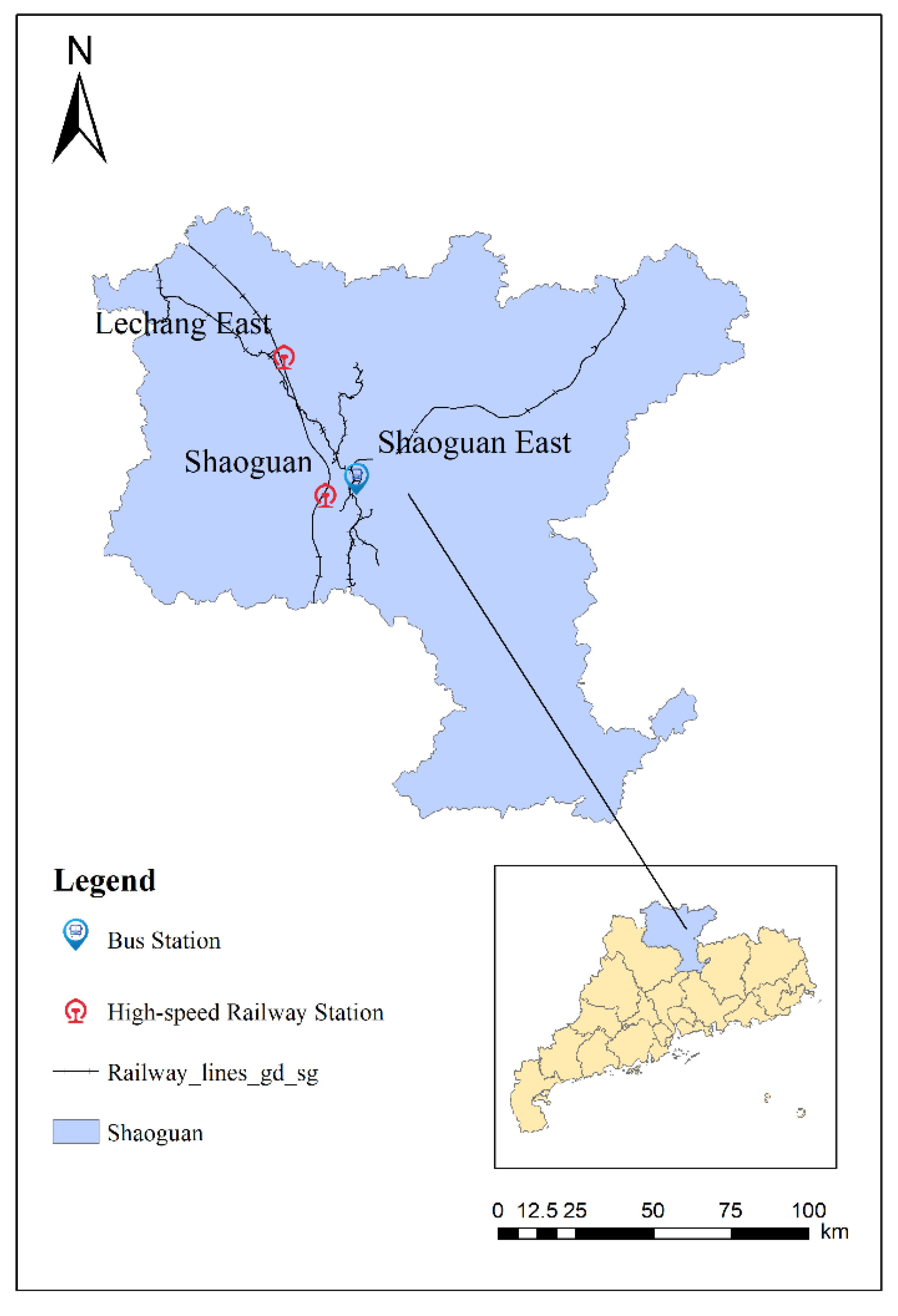



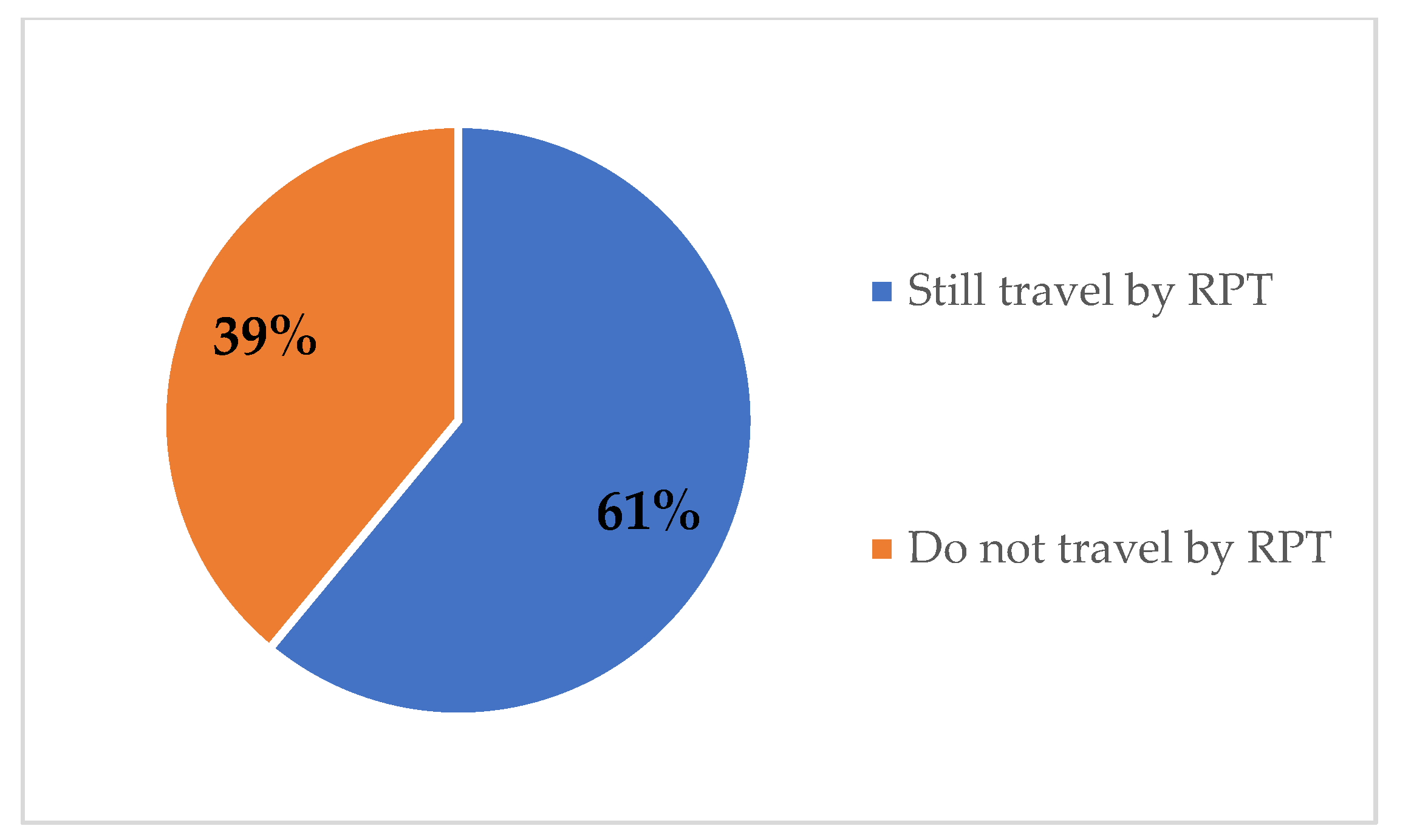
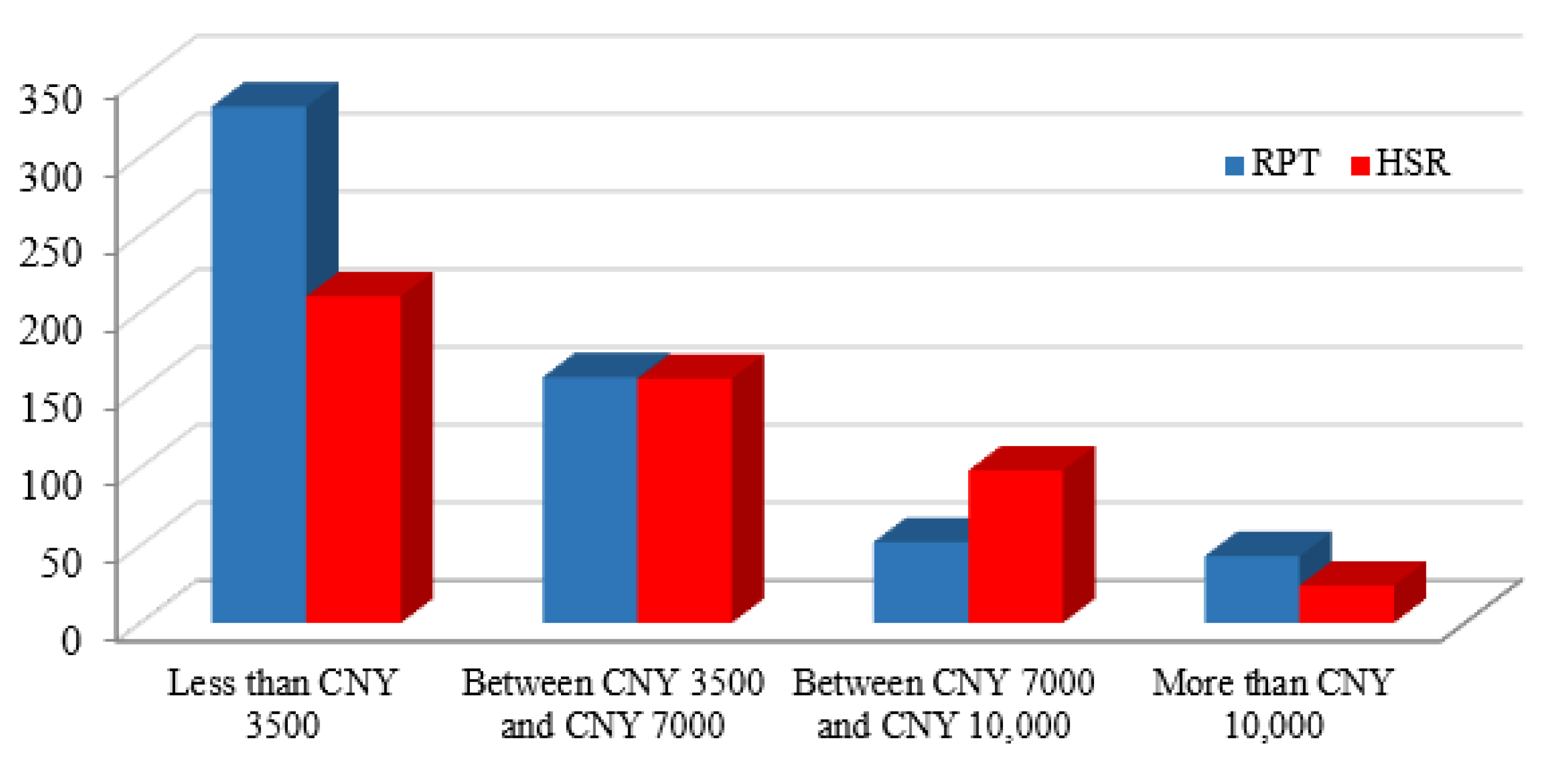
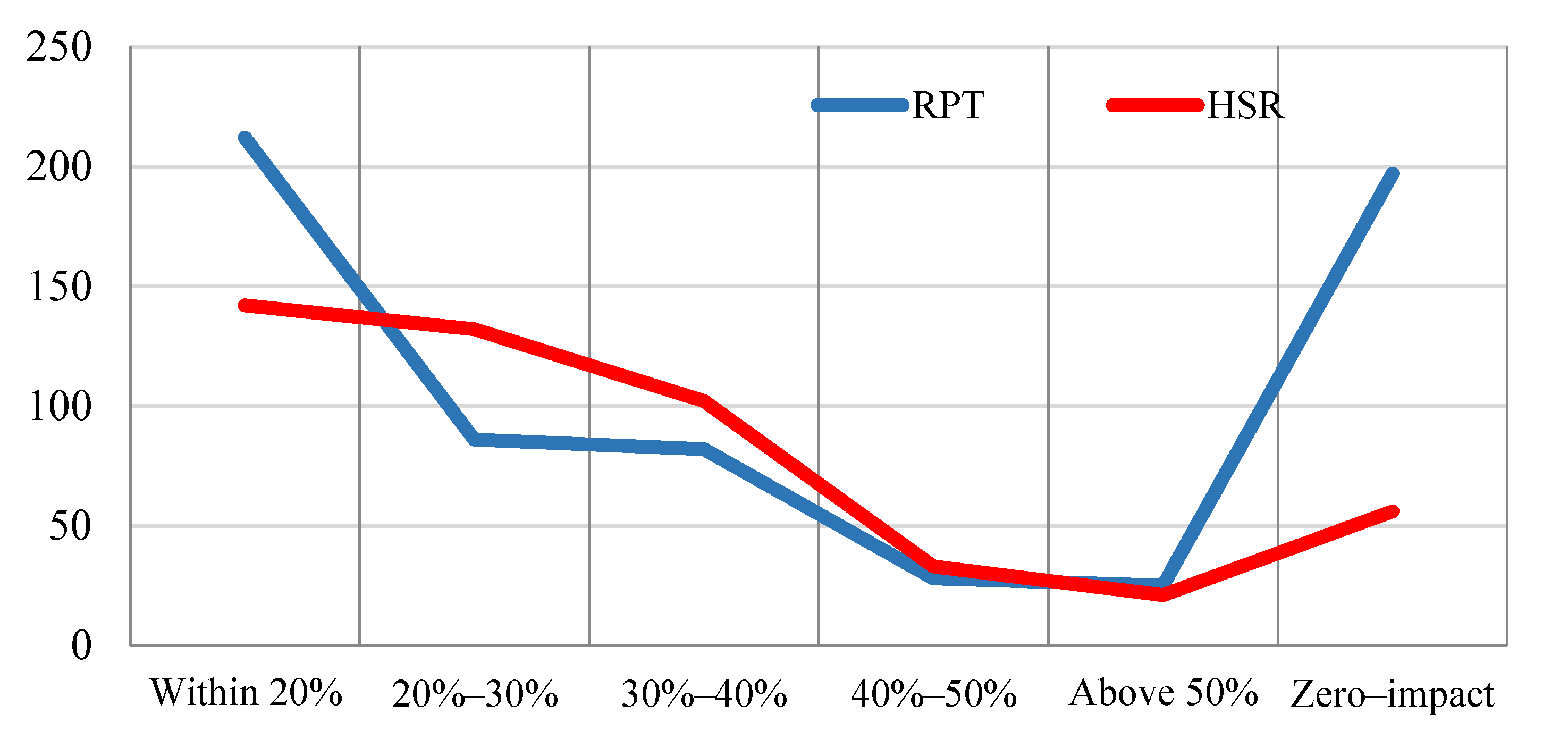
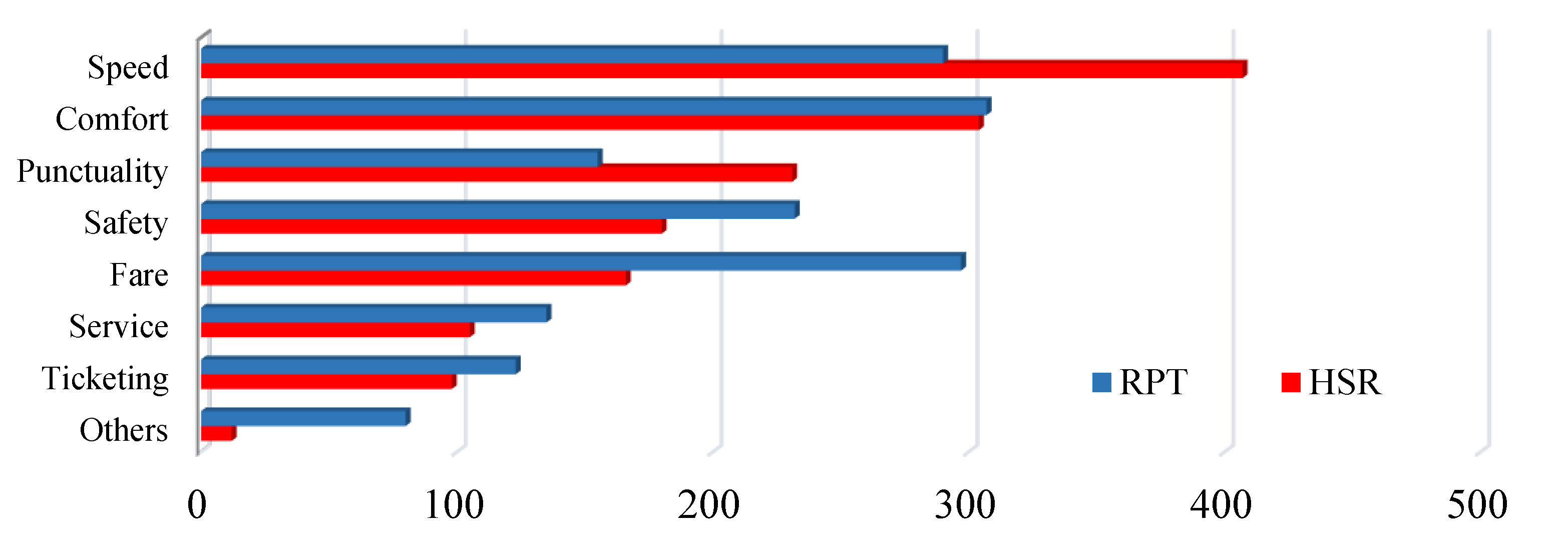

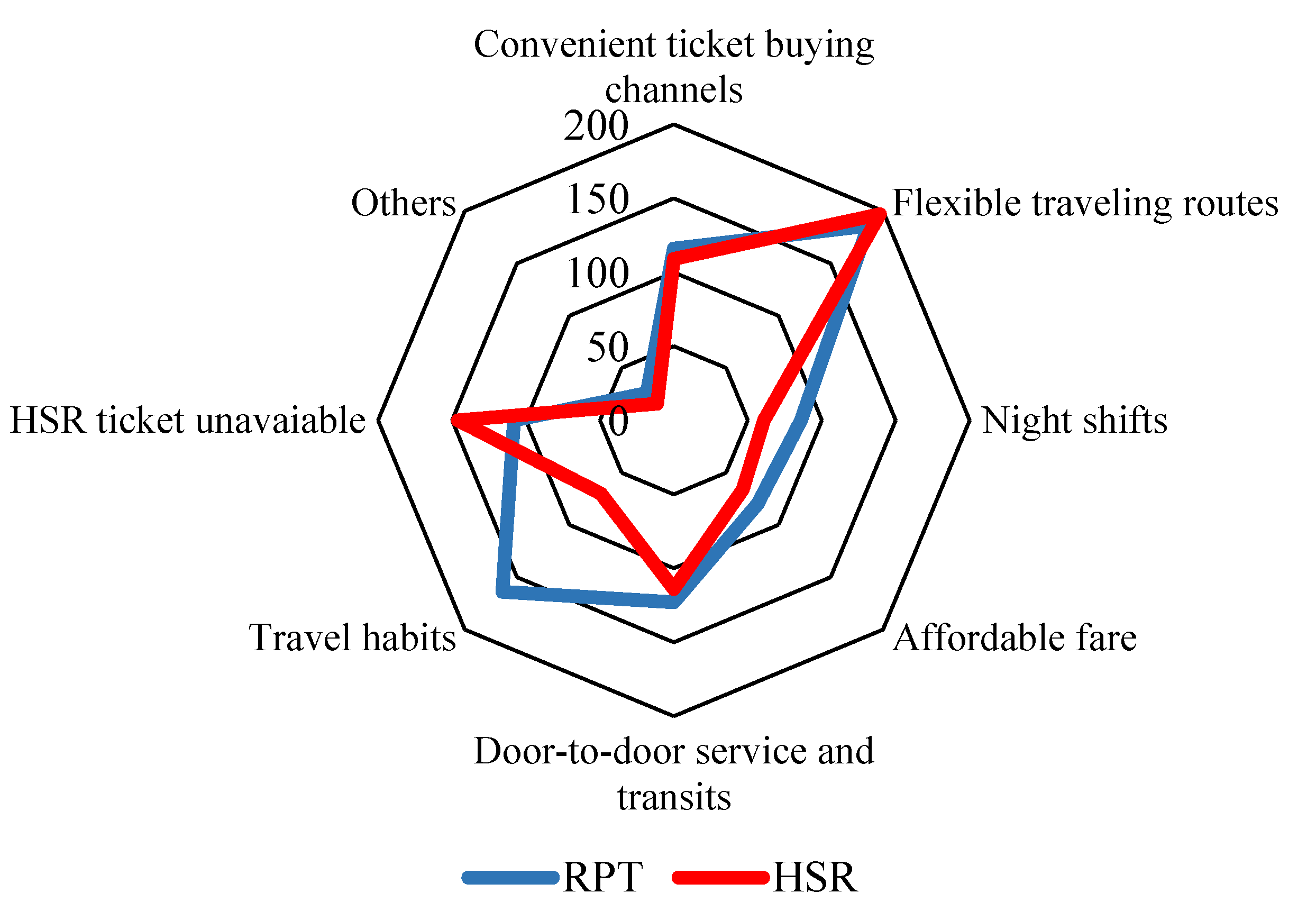

| Variable Name | Observation Value | Average | Standard Deviation | Variable Definition |
|---|---|---|---|---|
| Option | 1142 | 0.4597198 | 0.498593 | For passengers’ choice of transport mode, 1 indicates HSR and 0 indicates RPT |
| Rprice | 1142 | 0.725394 | 0.161835 | Utility of fare level assessment when passengers choose HSR |
| Rcom | 1142 | 0.7891419 | 0.158281 | Utility of extent of comfort assessment when passengers choose HSR |
| Rsafe | 1142 | 0.8162872 | 0.128284 | Utility of safety assessment when passengers choose HSR |
| Rcon | 1142 | 0.7632224 | 0.172356 | Utility of ease of ticket-buying assessment when passengers choose HSR |
| Rser | 1142 | 0.7978984 | 0.149539 | Utility of customer service assessment when passengers choose HSR |
| Cprice | 1142 | 0.6357268 | 0.160144 | Utility of fare level assessment when passengers choose RPT |
| Ccom | 1142 | 0.6028021 | 0.164913 | Utility of extent of comfort assessment when passengers choose RPT |
| Csafe | 1142 | 0.6611208 | 0.158691 | Utility of safety assessment when passengers choose RPT |
| Ccon | 1142 | 0.6982487 | 0.163379 | Utility of ease of ticket-buying assessment ticket when passengers choose RPT |
| Cser | 1142 | 0.6201401 | 0.151119 | Utility of customer service assessment ticket when passengers choose RPT |
| Option | Coef. (Std. Err.) | eb | ebStdX | dy/dx |
|---|---|---|---|---|
| Rprice | 1.783 *** | 5.95 | 1.335 | 0.405 |
| (0.46) | ||||
| Rcom | 1.754 *** | 5.776 | 1.32 | 0.398 |
| (0.47) | ||||
| Rsafe | 0.353 | 1.423 | 1.046 | 0.080 |
| (0.57) | ||||
| Rcon | 2.081 *** | 8.011 | 1.431 | 0.472 |
| (0.42) | ||||
| Rser | −0.763 | 0.466 | 0.892 | −0.173 |
| (0.51) | ||||
| Cprice | −1.311 *** | 0.27 | 0.811 | −0.297 |
| (0.48) | ||||
| Ccom | −0.912 ** | 0.402 | 0.86 | −0.207 |
| (0.44) | ||||
| Csafe | −1.682 *** | 0.186 | 0.766 | −0.382 |
| (0.45) | ||||
| Ccon | −0.569 | 0.566 | 0.911 | −0.129 |
| (0.44) | ||||
| Cser | 0.474 | 1.606 | 1.074 | 0.108 |
| (0.50) | ||||
| Constant | −1.513 *** | |||
| (0.58) | ||||
| Pseudo-R2 | 0.0656 | |||
| LR | 103.39 | |||
| CC | 63.75% |
| Shaoguan | Wenzhou | Shantou | |||||||
|---|---|---|---|---|---|---|---|---|---|
| Option | Coef. (Std. Err.) | eb | dy/dx | Coef. (Std. Err.) | eb | dy/dx | Coef. (Std. Err.) | eb | dy/dx |
| Rprice | 3.068 *** | 21.503 | 0.582 | 0.521 | 1.684 | 0.125 | 1.756 ** | 5.787 | 0.394 |
| (0.91) | (0.94) | (0.72) | |||||||
| Rcom | 2.037 | 7.669 | 0.387 | 1.173 | 3.23 | 0.281 | 2.270 *** | 9.68 | 0.509 |
| (1.26) | (1.35) | (0.69) | |||||||
| Rsafe | 1.821 * | 6.176 | 0.346 | −0.748 | 0.473 | −0.179 | 0.083 | 1.086 | 0.019 |
| (1.09) | (1.24) | (0.88) | |||||||
| Rcon | 3.433 *** | 30.981 | 0.652 | −0.696 | 0.499 | −0.167 | 1.774 *** | 5.897 | 0.398 |
| (0.75) | (1.00) | (0.68) | |||||||
| Rser | −2.160 * | 0.115 | −0.410 | 1.442 | 4.228 | 0.345 | −0.43 | 0.65 | −0.096 |
| (1.23) | (1.30) | (0.70) | |||||||
| Cprice | −3.079 *** | 0.046 | −0.584 | −1.743 * | 0.175 | −0.417 | −0.663 | 0.515 | −0.149 |
| (1.07) | (0.98) | (0.68) | |||||||
| Ccom | −3.120 *** | 0.044 | −0.592 | 1.178 | 3.248 | 0.282 | −0.346 | 0.708 | −0.078 |
| (1.02) | (1.19) | (0.62) | |||||||
| Csafe | −2.876 *** | 0.056 | −0.546 | −1.214 | 0.297 | −0.291 | −1.350 ** | 0.259 | −0.303 |
| (1.08) | (1.14) | (0.60) | |||||||
| Ccon | −1.334 | 0.263 | −0.253 | 0.179 | 1.197 | 0.043 | −0.586 | 0.556 | −0.132 |
| (0.94) | (1.00) | (0.68) | |||||||
| Cser | 1.151 | 3.163 | 0.219 | −0.319 | 0.727 | −0.077 | 0.109 | 1.115 | 0.025 |
| (1.03) | (1.30) | (0.73) | |||||||
| Constant | −0.711 | 0.207 | −2.416 *** | . | . | ||||
| (1.29) | (1.16) | (0.91) | |||||||
| Pseudo-R2 | 0.1847 | 0.0239 | 0.0584 | ||||||
| LR | 94.05 | 9.82 | 37.53 | ||||||
| CC | 70.62% | 58.05% | 65.12% | ||||||
Publisher’s Note: MDPI stays neutral with regard to jurisdictional claims in published maps and institutional affiliations. |
© 2022 by the authors. Licensee MDPI, Basel, Switzerland. This article is an open access article distributed under the terms and conditions of the Creative Commons Attribution (CC BY) license (https://creativecommons.org/licenses/by/4.0/).
Share and Cite
Yang, W.; Chen, Q.; Yang, J. Factors Affecting Travel Mode Choice between High-Speed Railway and Road Passenger Transport—Evidence from China. Sustainability 2022, 14, 15745. https://doi.org/10.3390/su142315745
Yang W, Chen Q, Yang J. Factors Affecting Travel Mode Choice between High-Speed Railway and Road Passenger Transport—Evidence from China. Sustainability. 2022; 14(23):15745. https://doi.org/10.3390/su142315745
Chicago/Turabian StyleYang, Wen, Quanliang Chen, and Jing Yang. 2022. "Factors Affecting Travel Mode Choice between High-Speed Railway and Road Passenger Transport—Evidence from China" Sustainability 14, no. 23: 15745. https://doi.org/10.3390/su142315745
APA StyleYang, W., Chen, Q., & Yang, J. (2022). Factors Affecting Travel Mode Choice between High-Speed Railway and Road Passenger Transport—Evidence from China. Sustainability, 14(23), 15745. https://doi.org/10.3390/su142315745






